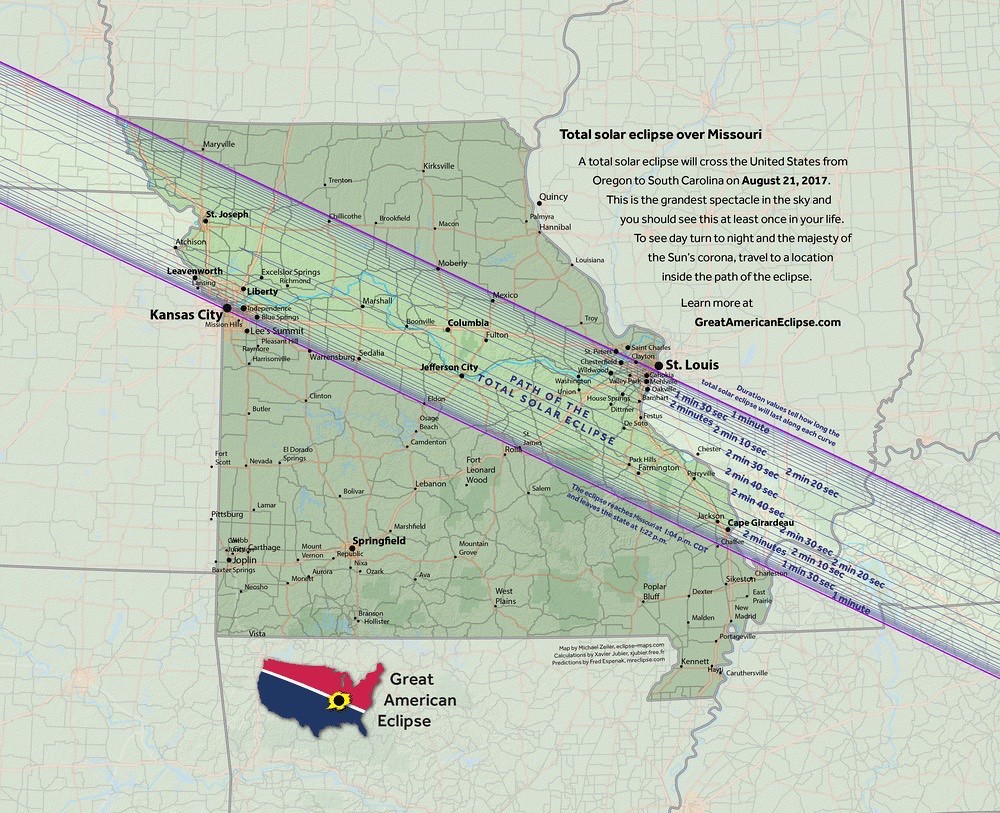The Great American Eclipse is Coming- Are You Ready?
photo credit: Space.com
The Great American Eclipse is coming Monday, August 21st, and St. Louis happens to be in the path for perfect viewing of the rare event, finding itself smack in the middle of the "totality band." The event will take place (depending on where you are in the St. Louis area) between approximately 1:15pm and 1:20pm, and will last about 1.5 minutes. This is undoubtedly a once-in-a-lifetime opportunity and a chance to inspire awe in the universe in our children. We've compiled a few tips on viewing the eclipse below.  Above: Map showing the path of total eclipse (photo credit: GreatAmericanEclipse.com)
Above: Map showing the path of total eclipse (photo credit: GreatAmericanEclipse.com)
Part of what makes this eclipse significant is that for the first time in American history, a total solar eclipse (where the moon will completely obscure the sun from view) will only be seen in the United States. Also of note: it is the first total solar eclipse since 1918 to move from coast to coast. Many of us may have observed partial solar eclipses, but be sure -these are a completely different experience. This one is not to be missed.
During a total solar eclipse, the moon passes between the Earth and the sun, casting its shadow on the ground. Normally, the moon reflects sunbeams off its surface, which is why darkness during a total solar eclipse is like nothing you’ve experienced before. The reflected light will disappear and all other light is blocked out. Because of this, the temperature will drop 10 - 15 degrees quite suddenly, and the sky will appear nighttime-dark (stars will be visible, but it will not be pitch black). Many scientists believe that animals will react to this event as well. Be sure to use all your senses during the eclipse; it may become eerily quiet as birds and insects fall quiet.
To understand the specialness of this day, it is important to reflect upon the universe and its ever-expanding nature:
"The moon wasn’t always where it is now, which makes the coincidence even more special. The moon has really just arrived at the 'sweet spot.' It’s been departing from us ever since its creation four billion years ago, after we were whacked by a Mars-size body that sent white-hot debris arcing into the sky. Spiraling away at the rate of one and a half inches per year, the moon is only now at the correct distance from our planet to make total solar eclipses possible. In just another few hundred million years, total solar eclipses will be over forever." -Wired
So how can you be sure that you and your family are prepared to view this phenomenal event? One important way to prepare for the eclipse is to be sure to have eclipse glasses on hand. They will protect eyes from the damage that could occur from viewing the sun just before and after the total eclipse, and can be bought on Amazon, or at the Science Center (while supplies last). Just be sure that they are ISO and CE certified. Explain the importance of wearing the glasses to your children beforehand. It is safe to remove eclipse glasses once the sun is completely obscured, but everyone should put them back on once a sliver of sunlight is again visible.
One way to build anticipation with children is to check NASA's official event site, where they will show an eclipse live stream. This will allow for viewing the world’s first live-stream of a total solar eclipse from near-space! There will be many visitors arriving in St. Louis and the surrounding area, so plan out your day in advance, being sure to leave plenty of travel time if you are planning to drive anywhere.
photo credit: HULTON-DEUTSCH COLLECTION/CORBIS/GETTY IMAGES
To find the perfect spot, can enter your location (even your address) at www.stlouiseclipse2017.org to determine best totality viewing sites. And be sure to check out this site for a great list of activities celebrating the event. Let's hope for clear skies on the 21st!



